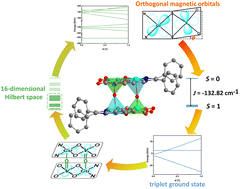Molecular-based magnetic materials are expected to serve as building blocks for quantum bits. To realize high-dimensional Hilbert space and addressability, we constructed anisotropic multi-level systems based on CuII and VIV with orthogonal magnetic orbitals. The crystal structures and intramolecular magnetic couplings of four CuIIVOII complexes [{CuVO(appen)2}2], [{CuVO(fhma)2EDA}2], [{CuVO(hfca)2EDA}2] and [CuVO(hfca)2DPEDA]n are characterized. Due to the orthogonal magnetic orbitals of CuII and VIV, the Cu–V pairs in the four complexes have strong ferromagnetic couplings, and the coupling strength is linearly related to the dihedral angle between the two equatorial planes of the two coordination polyhedra. Because of the triplet ground state, the system can be described by an effective Hamiltonian model consisting of two S = 1 spins coupled together. The anisotropy parameters of [{CuVO(hfca)2EDA}2] and [CuVO(hfca)2DPEDA]n were obtained by the simulation of X-band continuous wave electron paramagnetic resonance (cw-EPR) spectra, confirming that both complexes have zero-field splitting addressable on the relative energy scale. The results indicate that constructing multi-centre complexes based on orthogonal magnetic orbitals is a promising strategy for designing multidimensional quantum bits.
